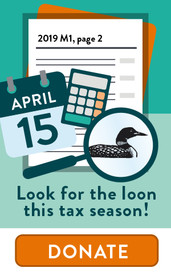|
|
|
January 31, 2020

Our "new" eagle couple seem to be on a "normal" Minnesota eagle egg-laying schedule. Fresh sticks, grasses and fur have been appearing in the nest over this past week as the couple perfect its layout. It seems this pair consume most of their meals away from the nest on the ground or in nearby trees. But they have brought some prey back to the nest, including small mammals, such as squirrels and rabbits.
|
The eagles’ behavior suggest that it won’t be long before they have some eggs to brood over. We can hardly wait! Here’s when the first egg appeared in the previous seven years we’ve been watching this pair:
- 2019 - no eggs
- 2018 - Feb 23
- 2017 Jan 28
- 2016: Jan. 25
- 2015: Jan. 19
- 2014: Feb. 14
- 2013: First week in January
When do you think the first eggs of 2020 will arrive? Keep your eagle eye tuned to the EagleCam.

This week a juvenile bald eagle was seen flying near the nest. The bird was not banded and did not attract attention from our resident pair. They seem to be quite comfortable in their new territory and have little, if any competition this year. Juvenile bald eagles are about the same size as their parents, but their coloring is different. The juveniles are mottled brown and white all over, with a brown beak and brown eyes. The characteristic dark body, yellow beak, white head and tail doesn't develop until the birds reach maturity at about five years of age.
|

Have you received your W2 forms yet, the statement of what you earned last year by getting up and going to work every day?
The eagles in our EagleCam go to work every day, too, but they don’t get a paycheck. The 800-plus species that the Nongame Wildlife Program helps through habitat management, research and other activities rely upon your generosity.
As you gather up your W2s and start filling out your income tax forms, look for the loon on line 22 of your Minnesota form and consider donating any amount you can. You can also donate directly online with a credit card, right now before it slips your mind.
Thank you for your interest in Minnesota’s wildlife, and for your ongoing support of the Nongame Wildlife Program, which has been bringing you live streaming video from an eagle’s nest for the past seven years.
|
|
|
|
|
Minnesota Nongame Wildlife Program
DNR’s Nongame Wildlife Program helps preserve and protect thousands of Minnesota wildlife species, some of them threatened or endangered. The program is supported almost entirely through voluntary donations, either directly or by designating an amount to donate on your Minnesota individual income tax form (look for the loon). Donations help us restore habitats, conduct crucial surveys and monitoring, engage in outreach and education (like our Eagle and Falcon cams), and complete other important projects. Visit mndnr.gov/nongame to learn more.
|
|